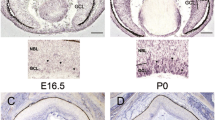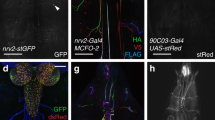Abstract
Ion channels formed by the TRP (transient receptor potential) superfamily of proteins act as sensors for temperature, osmolarity, mechanical stress and taste1,2. The growth cones of developing axons are responsible for sensing extracellular guidance factors, many of which trigger Ca2+ influx at the growth cone3,4; however, the identity of the ion channels involved remains to be clarified. Here, we report that TRP-like channel activity exists in the growth cones of cultured Xenopus neurons and can be modulated by exposure to netrin-1 and brain-derived neurotrophic factor, two chemoattractants for axon guidance. Whole-cell recording from growth cones showed that netrin-1 induced a membrane depolarization, part of which remained after all major voltage-dependent channels were blocked. Furthermore, the membrane depolarization was sensitive to blockers of TRP channels. Pharmacological blockade of putative TRP currents or downregulation of Xenopus TRP-1 (xTRPC1) expression with a specific morpholino oligonucleotide abolished the growth-cone turning and Ca2+ elevation induced by a netrin-1 gradient. Thus, TRPC currents reflect early events in the growth cone's detection of some extracellular guidance signals, resulting in membrane depolarization and cytoplasmic Ca2+ elevation that mediates the turning of growth cones.
This is a preview of subscription content, access via your institution
Access options
Subscribe to this journal
Receive 51 print issues and online access
$199.00 per year
only $3.90 per issue
Buy this article
- Purchase on Springer Link
- Instant access to full article PDF
Prices may be subject to local taxes which are calculated during checkout





Similar content being viewed by others
References
Clapham, D. E. TRP channels as cellular sensors. Nature 426, 517–524 (2003)
Montell, C., Birnbaumer, L. & Flockerzi, V. The TRP channels, a remarkably functional family. Cell 108, 595–598 (2002)
Hong, K., Nishiyama, M., Henley, J., Tessier-Lavigne, M. & Poo, M. Calcium signalling in the guidance of nerve growth by netrin-1. Nature 403, 93–98 (2000)
Henley, J. & Poo, M. M. Calcium mediates bidirectional growth cone turning induced by myelin-associated glycoprotein. Neuron 44, 909–916 (2004)
Henley, J. & Poo, M. M. Guiding neuronal growth cones using Ca2+ signals. Trends Cell Biol. 14, 320–330 (2004)
Nishiyama, M. et al. Cyclic AMP/GMP-dependent modulation of Ca2+ channels sets the polarity of nerve growth-cone turning. Nature 423, 990–995 (2003)
Ming, G. L. et al. cAMP-dependent growth cone guidance by netrin-1. Neuron 19, 1225–1235 (1997)
Kim, S. J. et al. Activation of the TRPC1 cation channel by metabotropic glutamate receptor mGluR1. Nature 426, 285–291 (2003)
Li, H. S., Xu, X. Z. & Montell, C. Activation of a TRPC3-dependent cation current through the neurotrophin BDNF. Neuron 24, 261–273 (1999)
Zhu, X., Jiang, M. & Birnbaumer, L. Receptor-activated Ca2+ influx via human Trp3 stably expressed in human embryonic kidney (HEK)293 cells. Evidence for a non-capacitative Ca2+ entry. J. Biol. Chem. 273, 133–142 (1998)
Schwarz, G., Droogmans, G. & Nilius, B. Multiple effects of SKF 96365 on ionic currents and intracellular calcium in human endothelial cells. Cell Calcium 15, 45–54 (1994)
Greka, A., Navarro, B., Oancea, E., Duggan, A. & Clapham, D. E. TRPC5 is a regulator of hippocampal neurite length and growth cone morphology. Nature Neurosci. 6, 837–845 (2003)
Song, H. J., Ming, G. L. & Poo, M. M. cAMP-induced switching in turning direction of nerve growth cones. Nature 388, 275–279 (1997)
Jung, S. et al. Lanthanides potentiate TRPC5 currents by an action at extracellular sites close to the pore mouth. J. Biol. Chem. 278, 3562–3571 (2003)
Inoue, R. et al. The transient receptor potential protein homologue TRP6 is the essential component of vascular alpha(1)-adrenoceptor-activated Ca(2 + )-permeable cation channel. Circ. Res. 88, 325–332 (2001)
Gomez, T. M., Robles, E., Poo, M. & Spitzer, N. C. Filopodial calcium transients promote substrate-dependent growth cone turning. Science 291, 1983–1987 (2001)
Li, Y. et al. Essential role of TRPC channels in the guidance of nerve growth cones by brain-derived neurotrophic factor. Nature doi:10.1038/nature03477 (this issue)
Bobanovic, L. K. et al. Molecular cloning and immunolocalization of a novel vertebrate trp homologue from Xenopus . Biochem. J. 340, 593–599 (1999)
Brereton, H. M., Harland, M. L., Auld, A. M. & Barritt, G. J. Evidence that the TRP-1 protein is unlikely to account for store-operated Ca2+ inflow in Xenopus laevis oocytes. Mol. Cell. Biochem. 214, 63–74 (2000)
Lintschinger, B. et al. Coassembly of Trp1 and Trp3 proteins generates diacylglycerol- and Ca2+-sensitive cation channels. J. Biol. Chem. 275, 27799–27805 (2000)
Strubing, C., Krapivinsky, G., Krapivinsky, L. & Clapham, D. E. TRPC1 and TRPC5 form a novel cation channel in mammalian brain. Neuron 29, 645–655 (2001)
Strubing, C., Krapivinsky, G., Krapivinsky, L. & Clapham, D. E. Formation of novel TRPC channels by complex subunit interactions in embryonic brain. J. Biol. Chem. 278, 39014–39019 (2003)
Xu, X. Z., Li, H. S., Guggino, W. B. & Montell, C. Coassembly of TRP and TRPL produces a distinct store-operated conductance. Cell 89, 1155–1164 (1997)
Amiri, H., Schultz, G. & Schaefer, M. FRET-based analysis of TRPC subunit stoichiometry. Cell Calcium 33, 463–470 (2003)
Schaefer, M., Plant, T. D., Stresow, N., Albrecht, N. & Schultz, G. Functional differences between TRPC4 splice variants. J. Biol. Chem. 277, 3752–3759 (2002)
Goel, M., Sinkins, W. G. & Schilling, W. P. Selective association of TRPC channel subunits in rat brain synaptosomes. J. Biol. Chem. 277, 48303–48310 (2002)
Hofmann, T., Schaefer, M., Schultz, G. & Gudermann, T. Subunit composition of mammalian transient receptor potential channels in living cells. Proc. Natl Acad. Sci. USA 99, 7461–7466 (2002)
Lohof, A. M. et al. Asymmetric modulation of cytosolic cAMP activity induces growth cone turning. J. Neurosci. 12, 1253–1261 (1992)
Gu, X. & Spitzer, N. C. Low-threshold Ca2+ current and its role in spontaneous elevations of intracellular Ca2+ in developing Xenopus neurons. J. Neurosci. 13, 4936–4948 (1993)
Schweitz, H. et al. Calcicludine, a venom peptide of the Kunitz-type protease inhibitor family, is a potent blocker of high-threshold Ca2+ channels with a high affinity for L-type channels in cerebellar granule neurons. Proc. Natl Acad. Sci. USA 91, 878–882 (1994)
Acknowledgements
We thank G. J. Barritt for the gift of xTRP-1 antibody. This work was supported by a grant from NIH and a NSF predoctoral fellowship (to G.X.W.)
Author information
Authors and Affiliations
Corresponding author
Ethics declarations
Competing interests
The authors declare that they have no competing financial interests.
Supplementary information
Supplementary Figure S1
Comparison of neurite growth in Xenopus spinal neurons with or without loading of xTRPC1 morpholino oligo (MO). (JPG 24 kb)
Supplementary Figure S2
Western blot of xTRPC1 on Xenopus spinal cord extracts. (JPG 24 kb)
Supplementary Figure S3
Voltage-dependent channels are not affected by the blockade of TRPC1. (JPG 37 kb)
Supplementary Figure Legends
Legends to accompany the above Supplementary Figures. (DOC 23 kb)
Rights and permissions
About this article
Cite this article
Wang, G., Poo, Mm. Requirement of TRPC channels in netrin-1-induced chemotropic turning of nerve growth cones. Nature 434, 898–904 (2005). https://doi.org/10.1038/nature03478
Received:
Accepted:
Published:
Issue Date:
DOI: https://doi.org/10.1038/nature03478
This article is cited by
-
Neogenin suppresses tumor progression and metastasis via inhibiting Merlin/YAP signaling
Cell Death Discovery (2023)
-
TRP Channels in Stroke
Neuroscience Bulletin (2023)
-
How filopodia respond to calcium in the absence of a calcium-binding structural protein: non-channel functions of TRP
Cell Communication and Signaling (2022)
-
Wireless neuromodulation in vitro and in vivo by intrinsic TRPC-mediated magnetomechanical stimulation
Communications Biology (2022)
-
Pre- and post-synaptic roles for DCC in memory consolidation in the adult mouse hippocampus
Molecular Brain (2020)
Comments
By submitting a comment you agree to abide by our Terms and Community Guidelines. If you find something abusive or that does not comply with our terms or guidelines please flag it as inappropriate.



